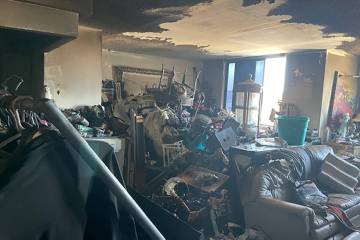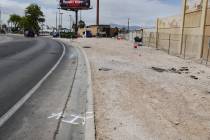Proposal aims to tighten rules for prescribing pain drugs
The Nevada Board of Osteopathic Medicine is considering new standards for treating patients with chronic pain to help prevent highly addictive painkillers from being dispensed to people without a medical need.
A proposal for new rules of conduct for doctors was unveiled to the board in December involving assessment, diagnosis, treatment and follow-up care for patients. The board’s legal counsel, Louis Ling, said the proposal starts a months-long process to develop rules targeting so-called pill mills and doctor-shopping that result in some patients receiving more medication than recommended.
The proposed regulations are a response to widespread misuse of prescription painkillers, specifically oxycodone and hydrocodone, that have become harder for patients to obtain since October when new rules went into effect regulating those prescriptions. Pills such as Norco, Lortab and Vicodin, which combine hydrocodone and acetaminophen, went from a Schedule III to a Schedule II designation, and the end result has made all medications containing oxycodone and hydrocodone harder for patients to acquire.
Ling’s proposal would replace wording in the rules governing osteopathic physicians that prevent them from prescribing pain pills “in a manner or an amount that the board determines is excessive.” If adopted, the new protocols would revise the Nevada Administrative Code to include steps a doctor of osteopathy must take to prescribe such pills.
The rules would not apply to patients suffering acute pain, which begins suddenly and can be caused by surgery, broken bones, burns or cuts, or can happen during labor and childbirth. Acute pain sufferers usually require pain relief only for a short period of time until their underlying conditions have healed. Chronic pain can persist even after an injury has healed, and patients can have symptoms for weeks, months or years. Chronic pain complaints involve back problems, cancer or arthritis, but sometimes can originate with an initial traumatic injury or infection.
Ling acknowledged he included more in his proposed regulatory changes than board members might want, but they are free to strike elements they deem onerous or unnecessary.
“We don’t have anything in our laws that says these things,” Ling said, adding similar rules recently were adopted in California and Colorado.
Ling called the proposal a “working draft” of strategies to eliminate any ambiguity in the current code. The clinical guidelines are similar to the model policy for painkiller use in the treatment of chronic pain from the Federation of State Medical Boards, the authority on issues related to licensure and discipline of medical doctors.
Dr. James Anthony, a Las Vegas family practitioner and secretary-treasurer of the board, said he wanted to ensure the new rules would not be a burden on practitioners and would apply only in the treatment of chronic pain, not acute pain. Anthony welcomed some guidelines, however, because of the way patients are capitalizing on the current system.
“On a daily basis, I’m dealing with patients that flat-out lie to me,” Anthony said.
Ling’s proposal would require doctors of osteopathy:
■ To conduct a medical history, physical examination and diagnostic testing of patients complaining of chronic pain conditions.
■ To diagnose the patient with intractable pain and develop a treatment plan.
■ To obtain consent from the patient explaining the risks for side effects and addiction possible with prolonged therapy with painkillers.
■ To monitor and adapt the treatment plan based on how the therapy is progressing.
Other provisions of the proposed rules address analyzing drug screens periodically, referring patients to specialists and terminating treatment if patients are found to be abusing or diverting pain medications.
Denise Selleck, executive director of the Nevada Osteopathic Medical Association, encouraged the board to consider rules that are the least cumbersome to comply with to ensure new requirements don’t drive doctors out of the business. Physicians also must be allowed to practice as they see fit.
“Patients are unique, and every situation is unique,” Selleck said.
The availability of opioid pain medications continues to cause problems at medical clinics throughout Southern Nevada. Some doctors are recommending their patients fill their prescriptions as early in the month as possible because pharmacies report shortages as the month progresses.
Other doctors suspect some pharmacies are limiting their supply of pain medications to their regular customers or only patients with a Southern Nevada address.
Even patients needing medications for acute pain have trouble filling their prescriptions. Dr. Tim Tollestrup, a Henderson peripheral nerve surgeon, recently had patients from California and Florida turned away from the same pharmacy where one of his local patients filled a prescription for the same pain medication.
Dr. Daniel Burkhead of Innovative Pain Care Center in Las Vegas said he feels helpless when advising patients how to obtain painkillers.
“It’s creating havoc in our office,” Burkhead said. “We’re at the point where we don’t know what to tell our patients, but we can’t help them receive their medications. We can only write the prescriptions.”
The next opportunity for the board to discuss the proposed clinical guidelines will be at its monthly meeting Jan. 13, and revisions also could be made during workshops before the plan is voted upon by the board. Selleck said her members will remain active participants in the process because providing the best patient care as efficiently as possible is paramount.
“No physician wants to have a patient become addicted to drugs. That’s never the plan,” she said. “Doctors, however, want the ability to treat patients appropriately.”
Contact Steven Moore at smoore@reviewjournal.com or 702-380-4563.






















